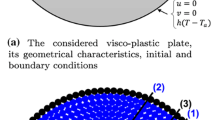Abstract
This paper presents a three-dimensional numerical simulation of material mixing observed in the friction stir welding process using a mesh-free approach. This mesh-free approach is based on the coupling of the moving least squares and the techniques of the asymptotic numerical method which is applied on a strong formulation to avoid numerical integration. The strong formulation is obtained from equations of the mass conservation and of the moment in the three-dimensional case. Numerical examples are given to illustrate that this mesh-free approach is accurate, effective and feasible, especially in the material mixing problem. Comparisons with the classical iterative solver are performed.















Similar content being viewed by others
References
Lancaster P, Salkauskas K (1981) Surfaces generated by moving least squares methods. Math Comput 37(155):141
Nayroles B, Touzot G, Villon P (1992) Generalizing the finite element method: diffuse approximation and diffuse elements. Comput Mech 10(5):307
Belytschko T, Lu YY, Gu L (1994) Element-Free Galerkin methods, reproducing kernel particle methods. Int J Numer Methods Eng 37(2):229
Liu WK, Jun S, Zhang YF (1995) Reproducing kernel particle methods. Int J Numer Methods Fluids 20:1081
Chen W (2002) Meshfree boundary particle method applied to Helmholtz problems. Eng Anal Bound Elem 16:577
Atluri SN, Zhu T (1998) A new meshless local Petrov–Galerkin MLPG approach in computational mechanics. Comput Mech 22(2):117
Zhang X, Song KZ, Lu MW, Liu X (2000) Meshless methods based on collocation with radial basis functions. Comput Mech 26:333
Wang JG, Liu GR (2002) A point interpolation method based on radial basis functions. Int J Numer Methods Eng 54:1623
Nayroles B, Touzot G, Villon P (1991) The diffuse approximation. Comptes Rendus de l’Académie des Sciences 313:293
Timesli A, Braikat B, Lahmam H, Zahrouni H (2013) An implicit algorithm based on continuous moving least square to simulate material mixing in friction stir welding process. Model Simul Eng 2013:14
Thomas WM, Nicholas ED, Needham JC, Church MG, Templesmith P, Dawes C (1991) Friction stir butt welding, friction stir butt welding (International Patent Application no. PCT/GB92/02203 and GB Patent Application no. 9125978.8., 1991)
Thomas WM, Nicholas ED (1997) Friction stir welding for the transportatition industries. Mater Des 18:269
Buffa G, Hua J, Shivpuri R, Fratini L (2006) Design of the friction stir welding tool using the continuum based FEM model. Acta Mater 419:381
Alfaro I, Bel D, Cueto E, Doblare M, Chinesta F (2006) Three-dimensional simulation of aluminium extrusion by the a-shape based natural element method. Comput Methods Appl Mech Eng 195:4269
Buffa G, Campanile G, Fratini L, Prisco A (2009) Friction stir welding of lap joints: Influence of process parameters on the metallurgical and mechanical properties. Mater Sci Eng A 519:19
Guerdoux S, Fourment L (2009) A 3D numerical simulation of different phases of friction stir welding. Model Simul Materials Sci Eng 17:075001
Buffa G, Hua J, Shivpuri R, Fratini L (2010) Mechanical and metallurgical effects of in process cooling during friction stir welding of AA7075-T6 butt joints. Mater Sci Eng 58:2056
Jacquin D, De Meester B, Simar A, Deloison D, Montheillet F, Desrayaud C (2011) A simple eulerian thermomechanical modeling of friction stir welding. J Mater Process Technol 211:57
Balokhonov RR, Romanova VA, Martynov SA, Zinoviev AV, Zinovieva OS, Batukhtina EE (2016) A computational study of the microstructural effect on the deformation and fracture of friction stir welded aluminum. Comput Mater Sci 116:2
Cochelin B (1994) A path-following technique via an asymptotic numerical method. Comput Struct 53:1181
Potier-Ferry M, Damil N, Braikat B, Descamps J, Cadou JM, Cao HL, Hussein AE (1997) Traitement des fortes non-linéarités par la méthode asymptotique numérique. Comptes Rendus de l’Académie des Sci Ser IIB Mech Phys Chem Astron 324(3):171
Cadou J, Damil N, Potier-Ferry M, Braikat B (2004) Projection techniques to improve high-order iterative correctors. Finite Elem Anal Des 41(3):285
Mottaqui H, Braikat B, Damil N (2010) Discussion about parameterization in the asymptotic numerical method: application to nonlinear elastic shells. Comput Methods Appl Mech Eng 199:1701
Mottaqui H, Braikat B, Damil N (2010) Local parameterization and the asymptotic numerical method. Math Model Nat Phenom 5:16
Hamdaoui A, Braikat B, Damil N (2016) Solving elastoplasticity problems by the Asymptotic Numerical Method: Influence of the parameterizations. Finite Elem Anal Des 115:33
Timesli A, Braikat B, Lahmam H, Zahrouni H (2015) A new algorithm based on Moving Least Square method to simulate material mixing in friction stir welding. Eng Anal Bound Elem 50:372
Mesmoudi S, Timesli A, Braikat B, Lahmam H, Zahrouni H (2017) A 2D mechanical-thermal coupled model to simulate material mixing observed in friction stir welding process. Eng Comput 33(4):885
Belaasilia Y, Timesli A, Braikat B, Jamal M (2017) A numerical mesh-free model for elasto-plastic contact problems. Eng Anal Bound Elem 82:68
Fornberg B, Whitham GB (1978) A numerical and theoretical study of certain nonlinear wave phenomena. Philos Trans R Soc Lond A Math Phys Eng Sci 289(1361):373
Allgower EL, Georg K (1979) Homotopy methods for approximating several solutions to nonlinear systems of equations. In: Homotopy methods for approximating several solutions to nonlinear systems of equations
Jamal M, Braikat B, Boutmir S, Damil N, Potier-Ferry M (2002) A high order implicit algorithm for solving instationary non-linear problems. Comput Mech 28:375
Author information
Authors and Affiliations
Corresponding author
Ethics declarations
Conflict of interest
The authors, Said Mesmoudi, Bouazza Braikat, Hassane Lahmam and Hamid Zahrouni, declare that there is no conflict of interest concerning the publication of the article entitled “Three-dimensional numerical simulation of material mixing observed in FSW using a mesh-free approach” and this article is original and has never been published. We look forward to hearing from you.
Rights and permissions
About this article
Cite this article
Mesmoudi, S., Braikat, B., Lahmam, H. et al. Three-dimensional numerical simulation of material mixing observed in FSW using a mesh-free approach. Engineering with Computers 36, 13–27 (2020). https://doi.org/10.1007/s00366-018-0683-6
Received:
Accepted:
Published:
Issue Date:
DOI: https://doi.org/10.1007/s00366-018-0683-6




